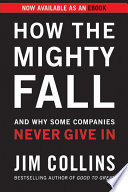

Jim Collins outlines five distinct stages that organizations typically go through on their path to decline. The first stage is 'Hubris Born of Success', where companies become complacent and overconfident, often ignoring the factors that led to their initial success. The second stage, 'Undisciplined Pursuit of More', highlights how organizations begin to expand without a clear strategy or understanding of their core competencies. The third stage, 'Denial of Risk and Peril', occurs when leaders refuse to acknowledge the signs of decline, leading to poor decision-making. The fourth stage, 'Grasping for Salvation', is characterized by desperate attempts to save the organization, often resulting in misguided strategies. Finally, 'Capitulation to Irrelevance or Death' signifies the ultimate failure of the organization, where it either fades into obscurity or ceases to exist altogether. Collins emphasizes that understanding these stages can help leaders recognize the warning signs of decline and take proactive measures to avoid them.
Continue readingCollins emphasizes the critical role of leadership in both the rise and fall of organizations. Effective leaders are those who remain humble and grounded, recognizing that success is not guaranteed. They foster a culture of discipline and accountability, encouraging their teams to stay focused on the organization's core mission. In contrast, leaders who exhibit hubris and arrogance can lead their organizations into decline. Collins argues that strong leadership is essential for navigating the complexities of business and adapting to changing environments. He highlights the importance of self-awareness and the ability to listen to feedback, as these traits can help leaders make better decisions and steer their organizations away from the pitfalls of decline.
Continue readingOne of the key themes in 'How the Mighty Fall' is the significance of maintaining core values and principles throughout an organization's lifecycle. Collins argues that companies that drift away from their foundational values are more likely to experience decline. He stresses that strong core values should guide decision-making and shape the organizational culture. When companies prioritize short-term gains over long-term principles, they risk losing their identity and purpose. Collins encourages organizations to revisit their core values regularly and ensure that they are reflected in their strategies and operations. By doing so, organizations can create a resilient framework that supports sustainable growth and helps them navigate challenges.
Continue readingComplacency is a significant threat to organizations, as Collins illustrates through various case studies. Once a company achieves success, it can become complacent and stop innovating or responding to market changes. This complacency can lead to a false sense of security, where leaders believe that past successes guarantee future performance. Collins warns that organizations must remain vigilant and continuously assess their competitive landscape. He advocates for a culture of learning and adaptation, where employees are encouraged to challenge the status quo and seek out new opportunities. By fostering an environment that values innovation and agility, organizations can mitigate the risks associated with complacency and maintain their competitive edge.
Continue readingDiscipline is a recurring theme in Collins' work, and 'How the Mighty Fall' is no exception. He argues that organizations must cultivate a disciplined approach to decision-making and execution to thrive in the long term. This discipline involves setting clear goals, adhering to established processes, and holding individuals accountable for their performance. Collins emphasizes that discipline should not be confused with rigidity; rather, it is about creating a framework that allows for flexibility and adaptability. Companies that lack discipline often find themselves making impulsive decisions that can lead to disastrous outcomes. By instilling a culture of discipline, organizations can enhance their resilience and better navigate the challenges they face.
Continue readingCollins highlights the value of feedback loops in preventing organizational decline. He argues that companies that actively seek and respond to feedback from employees, customers, and stakeholders are better equipped to identify potential issues early on. Feedback loops create a culture of transparency and open communication, allowing organizations to address problems before they escalate. Collins encourages leaders to create mechanisms for gathering feedback and to be receptive to constructive criticism. By fostering a culture that values input from all levels of the organization, companies can enhance their decision-making processes and remain agile in the face of change.
Continue readingInnovation is a crucial factor in sustaining organizational success, as Collins illustrates throughout the book. He argues that companies must prioritize innovation and continuously seek ways to improve their products, services, and processes. Organizations that become stagnant or fail to embrace change are at a higher risk of decline. Collins encourages leaders to create an environment that fosters creativity and experimentation, where employees feel empowered to propose new ideas and challenge existing norms. By prioritizing innovation, organizations can stay relevant in an ever-evolving marketplace and avoid the pitfalls of complacency and decline.
Continue reading